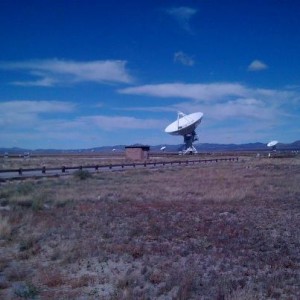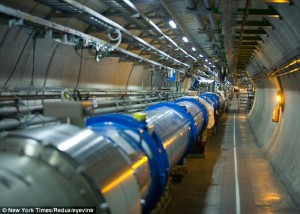Mixing NASA and Leonard Nimoy is always a recipe for success. Adding ion propulsion engines just makes it that much cooler. (via)
Category Archives: Science!
A Geek’s Guide to New Mexico
As some of you may know, Shane (my other half and sometimes blogger for Tosche Station) has been working out in New Mexico for the last few months, and since fall break was this week, I traveled out to see him, and we took the opportunity to investigate some of the geeky offerings that New Mexico has to offer, and I have been dispatched to share them with you.
We stayed mostly in the Albuquerque area, but the first thing we did was visit the Very Large Array, the world’s largest radio telescope.  It’s recently been upgraded into the Expanded Very Large Array (they’re really sticking with the imaginative names here), in order to revamp and bring the technology up to state of the art. Made up of 27 giant antennas that can be moved around three 21 mile long tracks, the VLA also serves as the control center and part of the Very Large Baseline Array, an array of telescopes that connects radio telescopes from Hawaii to the Caribbean to create one giant, continental radio telescope. You can tour the VLA most days if you’re in the area, but if you don’t find yourself in New Mexico, you can take a virtual tour via the National Radio Astronomy Observatory’s website. If you do go in person, know that once you get outside of Socorro, you should go ahead and turn off your cell phone; you’ll drain your battery as it searches for a signal, and when you get to the VLA, you have to turn off your cell phone and any other devices that might transmit radio signals, as they can interfere with observations (though turning your cell phone to airplane mode will allow you to be able to take pictures at the site).
It’s recently been upgraded into the Expanded Very Large Array (they’re really sticking with the imaginative names here), in order to revamp and bring the technology up to state of the art. Made up of 27 giant antennas that can be moved around three 21 mile long tracks, the VLA also serves as the control center and part of the Very Large Baseline Array, an array of telescopes that connects radio telescopes from Hawaii to the Caribbean to create one giant, continental radio telescope. You can tour the VLA most days if you’re in the area, but if you don’t find yourself in New Mexico, you can take a virtual tour via the National Radio Astronomy Observatory’s website. If you do go in person, know that once you get outside of Socorro, you should go ahead and turn off your cell phone; you’ll drain your battery as it searches for a signal, and when you get to the VLA, you have to turn off your cell phone and any other devices that might transmit radio signals, as they can interfere with observations (though turning your cell phone to airplane mode will allow you to be able to take pictures at the site).
For more geeky adventures, click to the jump. Continue reading
International Space Station Captures Dragon Capsule

Early this morning, the crew of the International Space Station reached out with its robotic arm and captured SpaceX’s Dragon module. The capture and eventual docking marks the first privately driven cargo delivery to the space station, something that could change the landscape of manned spaceflight.
The ramifications are potentially huge. If SpaceX can make these deliveries reliably, it frees NASA’s budget and brainpower to focus on other projects. Perhaps a high-capacity launch vehicle to send something like the Orion capsule beyond Low Earth Orbit? Of course, SpaceX still has some hurdles to clear in order to become that reliable. First and foremost, it’s got to figure out why one of its Falcon 9 engines failed during Sunday’s launch. Still, this is huge for SpaceX and for NASA. Further progress can get NASA out of the cargo and crew shuttling business and into more Final Frontier kind of exploration.
Rest in Peace, Dr. Sally Ride

When I was a little girl, I wanted to be an astronaut. Not long after moving to Florida, I became fascinated with space exploration and decided that was my future career, no questions asked. To seven-year-old me, it didn’t matter that I got motion sickness or that space travel was dangerous (the Challenger had just exploded two years prior, and I endured many questions of “doesn’t that scare you?” from classmates). All I knew was that I wanted to fly to the stars.
Nobody said to me, however, that I couldn’t be an astronaut. And when I went to Space Camp (four times, mind you), I wasn’t the only girl on my team: there were always a handful of others. Dr. Sally Kristen Ride is part of the reason for that.
Ride became an astronaut in 1978, the first class to include women. (The others were Anna Fisher, Shannon Lucid, Judy Resnik, Rhea Seddon, and Kathryn Sullivan.) She earned four degrees from Stanford University, including a doctorate in physics in 1978. Needless to say, she was quite qualified for her position as a mission specialist, and was the lucky woman chosen to be the first American woman in space. Her first flight was aboard STS-7, Challenger, in 1983. She also flew on another shuttle mission, STS-41G, in 1984.
I could go on and list all of Ride’s numerous awards and accomplishments, but that’s not what’s really important. What’s important is the inspiration Sally Ride gave to numerous girls and young women over the years. I never once thought “I can’t be an astronaut,” because women like her were brave enough to trailblaze new fields when they were being told they couldn’t. She continued to be an inspiration even after leaving the astronaut corps, founding Sally Ride Science, where she helped to encourage girls to pursue careers in science and mathematics. I know how important that is: I did my master’s thesis on female workers at Kennedy Space Center, and as part of my research I interviewed many female engineers who were told they couldn’t study science because that was a “man’s” subject.
I didn’t become an astronaut, obviously – I eventually realized that the motion sickness, and my lack of ability in science and math would be a hindrance to that career – but my interest in space exploration never waned. During graduate school I worked in the Kennedy Space Center Visitor Complex education department, and it was the funnest job I’ve ever had. I loved teaching little kids about space and hoping that they, like me, would be inspired by their time at KSC. And even though I never flew into space myself, I thank that ambition for my lifelong interest in science fiction.
To say I was saddened to hear the news of Sally Ride’s passing is an understatement. Not only was she an accomplished individual who inspired a generation of young girls – and boys – but 61 is far too young to die. I never got the chance to meet her or listen to her speak in person, but I will always be grateful for her contributions to science. Even more so, I thank her for the fact that she didn’t listen whenever someone said “girls can’t do that.”
Thank you, Dr. Sally Ride, and rest in peace.
The Higgs Boson All But Confirmed
In a coup for modern physics, scientists at CERN believe they have found proof of the Higgs Boson. While rumors have been abounding about this possible discovery of late, the Daily Mail just brought out a report last night that CERN is very close to having definitive proof (definitive being the difference between 99.99% sure and 99.99995% sure–semantics for most of us).
The Higgs Boson is probably the best definition for the Force–it very literally is what binds the universe together.

